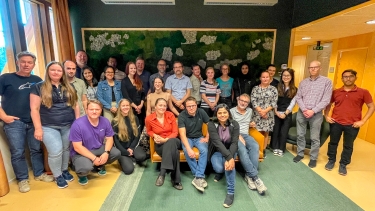A New Deal for European forests

This open letter reflects the personal opinion of Marc Palahí on the need for a strategic approach to and subsequent action on European forests. His opinions are based on participating in and following a great number of science-policy reports over the last five years, which have involved hundreds of scientists from different disciplines across the globe.
If we want a sustainable future, our forests are key. They can help transform the existing linear fossil economy into a new model - a circular bioeconomy which prospers in harmony with nature. This is crucial to achieve the goals of the EU Green Deal, ensuring a socially fair transition to a nature-positive and climate-neutral economy. But to realise this, we need action: a New Deal for European forests, rooted in three mutually reinforcing action plans for Adaptation-Restoration (Prestoration1), Innovation and Employment.
The post-2020 EU Forest Strategy needs to provide a new and convincing vision to understand why and how European forests, forestry and forest-based solutions can become a central pillar of the post-fossil economy. However, a new vision is not enough: we also need to bring it to action. The last EU Forest Strategy was a beautiful strategy, yet its impacts are questionable as it was not a strategic reference when forests were discussed in connection to climate, sustainable finance or biodiversity policy-making at European level. As Winston Churchill said “However beautiful the strategy, you should occasionally look at the results”. The new post-2020 Strategy needs to provide new lenses to see our forests not as “compensation” for the existing broken economic system but as a transformational force to create a better paradigm: a circular bioeconomy.
A visionary and actionable post-2020 EU Forest Strategy is urgently needed because in the next decade we will face an unprecedented situation as a result of the increasing risks affecting our forests and the emerging opportunities for the forest-based sector. On the one hand, climate change and natural disturbances could bring many of our forests to a tipping point where they can no longer provide the ecosystem services that we demand of them. On the other, forestry and the forest-based sector will face unique opportunities related to its potential to generate a new range of renewable, biobased solutions that are crucial to decarbonize our economy, while creating jobs for a socially and territorially fair transition. The “market traction” generated by these emerging opportunities is indispensable for financing the integrated adaptation-restoration measures required to ensure the health and resilience of European forests. At the same time, enhancing forest biodiversity is the most important investment that the forest sector can make to ensure its long-term economic resilience. Policy frameworks, investments and forest management need to acknowledge this by developing and implementing synergistic incentives and integrated approaches that connect mitigation and adaption efforts as well as bioeconomy and biodiversity goals.
Integrated approaches are key because the true challenge for the future is to increase simultaneously the ecological, economic and social value of EU forests. This requires a New Deal for European forests, a strategy articulated around three mutually reinforcing plans for Adaptation-Restoration, Innovation and Employment.
Adaptation-Restoration Plan
An integrated Adaptation-Restoration Plan is needed to ensure the long-term health and resilience of European forests to climate change and natural disturbances, so they can effectively provide valuable ecosystem services. The socio-ecological characteristics of European forests mean they require dynamic conservation and integrated management approaches to foster biodiversity at different (but coordinated) spatial scales: increasing tree species and genetic diversity to increase the resistance, resilience and adaptability of forests and restore rare and threatened forest ecosystem types; maintaining and restoring habitats of forest-dwelling species by promoting structurally diverse forests with sufficient amounts of deadwood and habitat trees; and coordinating landscape management and planning, including rural and urban areas, at regional and even transnational level to create biodiversity corridors and ensure the connectivity of high-value habitats. Such an ambitious plan, going beyond strictly protected areas, needs to empower private and public forest owners and provide incentives to the forest, agricultural and urban “sectors” to invest back in biodiversity: the true engine of a prosperous and long-term circular bioeconomy.
Innovation Plan
An Innovation Plan for the European forest-based sector is urgently needed to unlock its potential to create a circular and climate-neutral economy. Innovation is crucial because we need to do more with less: using forest resources efficiently, intelligently and sustainably. The plan should include massive investments in start-ups and scale-ups, access to finance and risk-taking capacity to stimulate new business models and value chains to decarbonize key industrial sectors such as textiles, construction, chemicals or transport using sustainable forest-based solutions. That requires public-private partnerships, venture funding and other dedicated funds operating at different phases and scales. Innovation should also address the need for new business models to market ecosystem services, for instance, connected to the provision of water and biodiversity or directly to human health and wellbeing. Finally, from an innovation demand perspective, procurement policies, certification and product labelling to guide consumption and investments are also a priority.
Employment Plan
An Employment Plan centered around forests and the forest-based sector is key for a socially fair and green transition in Europe. The forest sector in the EU already generates more jobs than the three energy-intense industries of cement, steel and chemicals combined. An employment plan is needed to create the human capacities required to develop the forest bioeconomy while restoring and adapting European forests. This plan should focus on both capacity building and upgrading the skills of existing forest-based workers, and training new workers, including those expected to lose their jobs as result of the green transition. The employment plan should be innovation-based and future-oriented (designed in connection with the innovation plan) building on the strengths of Europe’s researchers, entrepreneurs, managers and existing forest companies and workers. The forest-based sector in the EU already includes more than 400,000 small and medium enterprises while the current employment in the forestry and extended wood-based value chains amounts to 4.5 million people. The forest-based sector provides the greatest basis for green jobs in Europe but still the EU Green Deal has not been able to realise that.
The post-2020 EU Forest Strategy is crucial to achieve the goals of the EU Green Deal, ensuring a socially fair transition to a nature-positive and climate-neutral economy. It is essential that the new Strategy is science-informed, engaging the scientific community not only during its development but also for its implementation. The EU urgently needs institutionalized mechanisms to ensure an effective, balanced and transparent science-policy-practice dialogue to speed up knowledge uptake by policy makers and decision-makers. There is also a need for a collective European effort to generate robust and harmonized data and information to holistically understand and anticipate the effects of climate change, natural disturbances, forest management and global markets on European forests. The best way to predict the forests we will have is by deciding the future that we want.
1An actionable strategy to combine forest restoration and adaptation principles as basis for creating resilient forests. More information here.
More info: Marc Palahí, Director, EFI, marc.palahi @ efi.int
Photo: ©AA+W /StockAbobe


